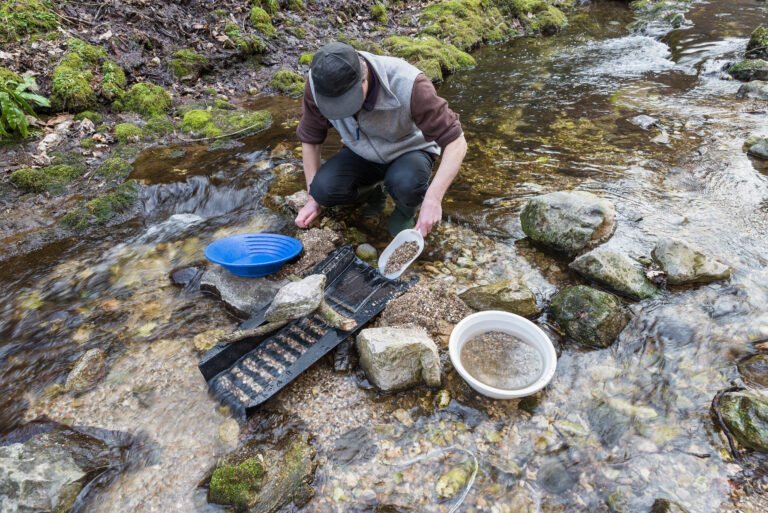Despite technological advancements, mining continues to have a significant impact on the environment.
First Posted October 1, 2025 | Last Updated on October 1, 2025 by Ryan ConlonDisclosure: This Post Contains Affiliate Links; We earn a commission on purchases.
That’s why there is a growing push for the mining industry to adopt more sustainable practices and reduce its footprint.
Responsible gold panning practices play a crucial role in ensuring sustainable gold mining.
By implementing eco-friendly and ethical approaches, miners can contribute to a more environmentally conscious industry.
From minimizing the use of harmful chemicals to rehabilitating mining sites, there are various strategies that can make a positive difference.
In this article, we will explore the importance of responsible gold panning practices and how they can help minimize the environmental impact of gold mining.
Key Takeaways:
- Responsible gold panning practices are essential for minimizing the environmental impact of gold mining.
- Adopting sustainable mining practices and minimizing the use of harmful chemicals contribute to eco-friendly gold panning.
- Rehabilitating mining sites and shutting down illegal mining operations are crucial steps towards responsible gold prospecting.
- Efficient energy management strategies can help reduce the carbon footprint of gold mining operations.
- By embracing responsible gold panning practices, the mining industry can become more ethical and environmentally conscious.
Lower-Impact Mining Techniques
Traditional mining techniques, such as open pit and underground mining, pose significant environmental risks. However, embracing new, alternative low-impact mining techniques like in-situ leaching can greatly reduce the industry’s environmental footprint. These techniques not only minimize surface disturbance at mining sites but also help lower soil erosion and reduce the volume of backfilled material. The result is a significant reduction in environmental impact and faster site recovery.
In-situ leaching is a method that involves extracting minerals from ore bodies without physically excavating and removing the rock. Instead, a leaching solution is injected into the deposit, dissolving the valuable minerals. This environmentally friendly technique eliminates the need for extensive excavation and reduces surface disturbance and soil erosion.
One of the key advantages of in-situ leaching is its ability to minimize surface disturbance at mining sites. As the process takes place underground, there is no need for large-scale excavation, mitigating the visual impact on the landscape. This is particularly important in environmentally sensitive areas where preserving the natural beauty is crucial.
Besides reducing surface disturbance, in-situ leaching also minimizes the amount of material that needs to be backfilled. In traditional mining methods, the excavated material must be replaced after the mineral extraction is complete. This process often requires significant resources and can create disturbances and additional soil erosion. However, with in-situ leaching, there is no need for extensive backfilling, resulting in less material displacement and environmental impact.
Moreover, by reducing surface disturbance and minimizing soil erosion, in-situ leaching allows for quicker site revegetation or rehabilitation. When the land is disturbed through traditional mining methods, it can take a long time for vegetation to regrow and restore the ecological balance. With in-situ leaching, the disruption is significantly reduced, enabling a faster recovery of the site and the return of native plant species.
Implementing lower-impact mining techniques like in-situ leaching is a crucial step towards reducing the environmental impact of mining operations. By minimizing surface disturbance, lowering soil erosion, and speeding up site recovery, these techniques offer a more sustainable approach to mining. Mining companies and industry stakeholders must continue to explore and adopt such practices to ensure responsible and eco-friendly resource extraction.
Reusing Mining Waste
Mining operations naturally generate substantial amounts of waste, including waste rocks, mine water, and tailings. However, instead of considering them as entirely burdensome, these waste products can be repurposed in several eco-friendly ways to minimize environmental impact and promote sustainable practices.
Waste Rocks: Building a Solid Foundation
One way to reduce the environmental footprint of mining is by reusing waste rocks in on-site construction. Waste rocks can be utilized for backfilling voids and reconstructing mined terrain, effectively preventing soil erosion and enhancing stability. By incorporating waste rocks into construction projects, mining companies can make responsible use of these materials while simultaneously reducing the need for sourcing additional aggregates.
Mine Water: From Contaminant to Resource
Transforming mine water from a potential environmental hazard into a valuable resource is another innovative approach to reuse mining waste. Through appropriate treatment methods, mine water can be purified and repurposed for various applications. Agricultural irrigation, dust suppression in mining areas, and even supply for drinking water can be accomplished by effectively reusing treated mine water. This sustainable practice conserves freshwater resources while reducing the ecological impact of mining operations.
Tailings: From Byproduct to Versatile Applications
Even toxic tailings, which historically posed significant environmental threats, can find eco-friendly uses. Tailings can be repurposed and transformed into valuable materials for different industries. For instance, tailings can be utilized in the production of bricks or as additives in the manufacturing of paint, offering sustainable alternatives to traditional raw materials. Additionally, technological advancements allow for further mining from tailings, reducing the volume of waste stored in tailings dams and minimizing the overall ecological impact of mining operations.
By embracing the principle of reusing mining waste, the mining industry can make significant strides towards sustainable practices, minimizing its environmental footprint and contributing to a more eco-friendly future.
| Waste Product | Eco-Friendly Use |
|---|---|
| Waste Rocks | Backfilling, reconstructing mined terrain |
| Mine Water | Agricultural irrigation, dust suppression, drinking water supply |
| Tailings | Production of bricks, paint additives, further mining |
Eco-Friendly Equipment
Mining companies have the opportunity to significantly reduce their environmental impact by embracing eco-friendly equipment. By shifting from traditional diesel-driven options to battery-driven mining equipment with electric engines, these companies can achieve substantial reductions in CO2 emissions. The mining industry is already undergoing a transition towards more sustainable equipment options, with manufacturers developing innovative and eco-friendly alternatives.
Upgrading to more durable equipment is another effective way to minimize the environmental impact of mining operations. By investing in long-lasting and resilient machinery, mining companies can reduce turnover and the resources required for frequent replacements. This not only helps to decrease waste but also contributes to cost-saving measures.
For instance, simple switches in tire selection can go a long way in promoting sustainability. By opting for tires that offer better longevity and improved fuel efficiency, mining companies can cut down on costs and further reduce waste. These small changes add up and make a significant difference in the industry’s overall environmental impact.
Switching to battery-driven mining equipment and using electric engines are effective strategies for reducing CO2 emissions and embracing eco-friendly practices. Investing in durable equipment, such as long-lasting machinery and better tires, helps mining companies minimize waste and lower their environmental footprint.
By prioritizing eco-friendly equipment, mining companies can align their operations with sustainable practices and contribute to the broader goal of reducing environmental harm in the industry.
Benefits of Eco-Friendly Equipment
The adoption of eco-friendly equipment in the mining industry offers several advantages, including:
- Reduced CO2 emissions, resulting in a smaller carbon footprint
- Improved air quality and reduced pollution in mining areas
- Cost savings through lower energy consumption and reduced maintenance
- Enhanced corporate social responsibility and public image
- Compliance with environmental regulations
Eco-friendly equipment not only benefits the environment but also presents a strategic business advantage for mining companies, attracting environmentally conscious investors and customers who prioritize sustainability.
Comparison of CO2 Emissions: Battery-Driven vs. Diesel-Driven Equipment
| Equipment Type | CO2 Emissions |
|---|---|
| Battery-Driven Mining Equipment with Electric Engines | Significantly reduced emissions compared to diesel-driven options |
| Diesel-Driven Mining Equipment | Higher CO2 emissions and environmental impact |
The table above illustrates the stark contrast between battery-driven mining equipment with electric engines and diesel-driven alternatives in terms of CO2 emissions. Choosing eco-friendly equipment helps mining companies combat climate change and contribute to global efforts to reduce greenhouse gas emissions.
Rehabilitating Mining Sites
Modern mining techniques can have significant environmental impacts, including land disturbance, soil erosion, and depletion of natural resources. However, there are land rehabilitation techniques that can help restore the productivity and ecological balance of mining sites. Implementing these techniques is crucial to minimizing the long-term effects of mining activities and promoting sustainability in the industry.
Land Disturbance and Soil Erosion
Mining operations often strip away the topsoil, disrupting the natural soil ecosystem and exposing the underlying earth to erosion. This can lead to the loss of valuable nutrients, hinder plant growth, and contribute to sedimentation in nearby water bodies. Additionally, mining activities can alter the pH levels of the soil and water, making it unsuitable for many plant species.
Rehabilitating mining sites involves restoring the soil and vegetation, thereby reducing land disturbance and soil erosion. One technique to achieve this is by using biosolids, which are organic materials derived from wastewater treatment processes. These biosolids can be spread over the mined land to replenish the depleted topsoil and provide essential nutrients for plant growth.
Furthermore, waste rocks generated during mining operations can be strategically used to fill the excavated areas. This helps to restore the natural contours of the land, prevent soil erosion, and minimize the visual impact of the mining site. By utilizing waste rocks in this way, mining companies can effectively manage the land disturbance caused by their activities.
Reforestation for Land Rehabilitation
Reforestation plays a crucial role in rehabilitating mining sites, rejuvenating the ecosystem, and providing habitat for various species. Some mining companies have implemented large-scale reforestation schemes, where they plant native tree species to restore the surroundings before mining operations begin. This proactive approach helps maintain a healthy ecosystem and ensures minimal disruption to the natural environment.
Land Rehabilitation Techniques
Aside from biosolids application and reforestation, there are various other land rehabilitation techniques that mining companies can employ. These techniques aim to restore the land’s productivity, enhance biodiversity, and promote sustainable land use. Some common techniques include:
- Soil stabilization: Implementing erosion control measures, such as contouring, terracing, and adding organic matter, to prevent further land degradation.
- Hydroseeding: A method that involves spraying a mixture of seeds, soil additives, and water onto the barren land to accelerate vegetation growth.
- Vegetative covers: Planting specific grasses or legumes that help restore the soil structure, prevent erosion, and improve soil fertility.
- Wetland restoration: Rehabilitating natural wetlands within mined areas to support aquatic biodiversity and enhance water quality.
Shutting Down Illegal Mining
Illegal mining continues to be a major concern in the mining industry, leading to significant environmental damage and a disregard for regulations. Taking action to shut down illegal or unregulated mining operations is crucial to ensure that all mining activities adhere to environmental standards and promote accountability.
By addressing the issue of illegal mining, it becomes possible to reduce the overall environmental impact of the mining industry. Illegal mining often involves practices that contribute to deforestation, water pollution, and soil degradation. These activities not only harm ecosystems but also pose risks to human health and safety.
To combat illegal mining, governments and mining regulatory bodies need to strengthen their enforcement efforts. This includes implementing stricter penalties for those involved in illegal mining activities and increasing surveillance and monitoring of mining operations. Additionally, collaboration between law enforcement agencies, local communities, and mining companies is essential to reporting and identifying illegal mining activities.
Furthermore, promoting transparency and accountability within the mining sector is crucial for preventing illegal mining. Mining companies should strive to implement traceability systems that track the origin and movement of minerals from mining sites to the market. By ensuring that minerals are sourced from legal and responsible mines, companies can help eliminate the demand for illegal mining activities.
“Shutting down illegal mining operations is crucial to protect the environment and uphold environmental standards. By promoting accountability and collaboration, we can work towards a more sustainable and ethical mining industry.”
The consequences of illegal mining go beyond environmental damage. It also contributes to social and economic issues, such as the exploitation of workers, the loss of revenue for governments, and the perpetuation of poverty in mining communities. By shutting down illegal mining, communities can be protected, and efforts can be focused on responsible mining practices that prioritize the well-being of the environment and local populations.
The Environmental Impact of Illegal Mining
| Environmental Impact | Description |
|---|---|
| Deforestation | Illegal mining activities often involve clearing large areas of forest, leading to habitat destruction and the loss of biodiversity. |
| Water Pollution | Illegal miners frequently use toxic chemicals such as mercury and cyanide, contaminating rivers and groundwater sources. |
| Soil Degradation | Illegal mining practices, such as open-pit mining, can result in soil erosion, destabilizing the land and affecting agricultural productivity. |
| Hazardous Waste Disposal | Illegal mining often involves improper disposal of mining waste, such as tailings, which can contaminate nearby ecosystems. |
| Land Encroachment | Illegal mining operations often encroach upon protected areas, disrupting fragile ecosystems and threatening endangered species. |
By taking decisive action against illegal mining, we can protect the environment, uphold environmental standards, and foster transparency and accountability within the mining industry. It is crucial for governments, regulatory bodies, mining companies, and communities to work together in shutting down illegal mining operations and promoting responsible and sustainable mining practices.
Efficient Energy Management Strategies Revolutionizing Mining Sector Sustainability
The mining sector recognizes the importance of adopting efficient energy management strategies to reduce its environmental impact and promote sustainability. By implementing these strategies, mining companies can integrate renewable energy sources, utilize energy-efficient equipment and technologies, and establish robust energy management systems. These efforts to minimize energy consumption not only contribute to cost savings but also have a positive effect on the environment by reducing greenhouse gas emissions.
One of the key strategies employed by the mining sector is the integration of renewable energy sources into mining operations. This includes utilizing solar power, wind energy, and hydropower to generate electricity for various mining processes. By leveraging renewable energy, which has a lower environmental impact compared to fossil fuel-based energy sources, mining companies can significantly reduce their carbon footprint and contribute to sustainable development.
Benefits of Renewable Energy Integration in Mining Operations
- Reduces dependency on non-renewable energy sources and fossil fuels
- Lowers greenhouse gas emissions, mitigating climate change effects
- Decreases operational costs in the long term as renewable energy becomes more affordable
- Minimizes environmental impact by reducing air pollution and water consumption
- Enhances corporate reputation and demonstrates commitment to sustainable practices
In addition to renewable energy integration, mining companies are embracing energy-efficient equipment and technologies. Advanced mining equipment, such as electric trucks and loaders, utilize energy-efficient motors and batteries, resulting in reduced energy consumption and lower CO2 emissions. By investing in durable equipment that requires less maintenance and consumes less energy, mining companies can achieve long-term cost savings and minimize their environmental footprint.
To optimize energy usage and monitor energy consumption, mining companies are implementing robust energy management systems. These systems enable real-time monitoring and analysis of energy usage, identify areas of inefficiency, and provide insights for energy optimization. By identifying energy-saving opportunities and implementing energy management strategies, mining companies can further reduce their energy consumption, leading to both cost savings and environmental benefits.
“Efficient energy management strategies are revolutionizing the mining sector, paving the way for a more sustainable and environmentally conscious industry. By integrating renewable energy sources, utilizing energy-efficient equipment, and implementing robust energy management systems, mining companies can achieve significant reductions in energy consumption, leading to cost savings and a decreased environmental impact.”
In conclusion, efficient energy management strategies are driving the sustainability efforts of the mining sector. The integration of renewable energy sources, utilization of energy-efficient equipment, and implementation of robust energy management systems are key steps towards reducing energy consumption, lowering environmental impact, and promoting sustainable development. Mining companies that embrace these strategies not only achieve cost savings but also demonstrate their commitment to building a greener and more responsible mining industry.
| Key Benefits of Efficient Energy Management Strategies | Examples |
|---|---|
| Reduced energy consumption | Integration of solar panels to power mining operations |
| Cost savings | Utilizing energy-efficient mining equipment and technologies |
| Lower greenhouse gas emissions | Implementing energy management systems to optimize energy usage |
| Enhanced corporate reputation | Investing in sustainable practices and renewable energy integration |
Conclusion
Responsible gold panning practices play a crucial role in minimizing the environmental impact of mining operations. By adopting sustainable mining practices, such as implementing lower-impact techniques, reusing mining waste, using eco-friendly equipment, rehabilitating mining sites, and shutting down illegal mining, the mining industry can contribute to a more sustainable future.
Minimizing the environmental impact of gold panning requires a proactive approach. Lower-impact mining techniques like in-situ leaching can reduce surface disturbance and soil erosion, while reusing mining waste, such as waste rocks and mine water, can have eco-friendly applications. Adopting eco-friendly equipment, such as battery-driven or electric engines, can significantly reduce CO2 emissions and promote a cleaner mining industry.
Furthermore, rehabilitating mining sites through land rehabilitation techniques and large-scale reforestation schemes are essential for restoring the environment and supporting local ecosystems. By adhering to responsible gold panning practices and efficiently managing energy consumption through renewable energy integration, mining companies can further minimize their carbon footprint and promote sustainable mining practices.
Responsible gold panning is not only about minimizing the environmental impact but also about taking an ethical and responsible approach to mining. It is a commitment to preserving the environment, protecting local communities, and ensuring a sustainable future for all. By embracing these practices, the mining industry can pave the way towards a more responsible and sustainable gold mining sector.
Source Links
- https://ioccompany.com/iron-a-biological-element/
- https://empoweringpumps.com/5-ways-to-make-mining-more-sustainable/
- https://utilitiesone.com/sustainable-mining-practices-reducing-energy-consumption

Meet Ryan Conlon, the passionate owner and driving force behind Pan for Treasure.
With an unwavering love for the art of gold panning, Ryan has transformed his enthusiasm into a thriving community hub for fellow treasure seekers. info@panfortreasure.com
A seasoned gold panning enthusiast, Ryan’s journey began with a simple pan and a dream, evolving into a deep appreciation for the history, geology, and thrill of uncovering precious metals.
Subscribe to Our Newsletter







